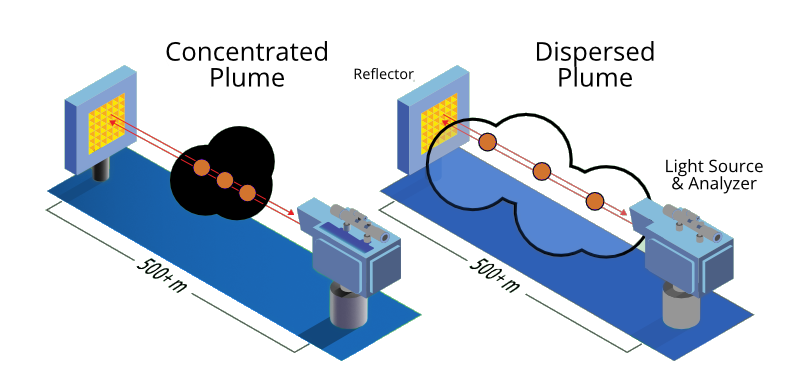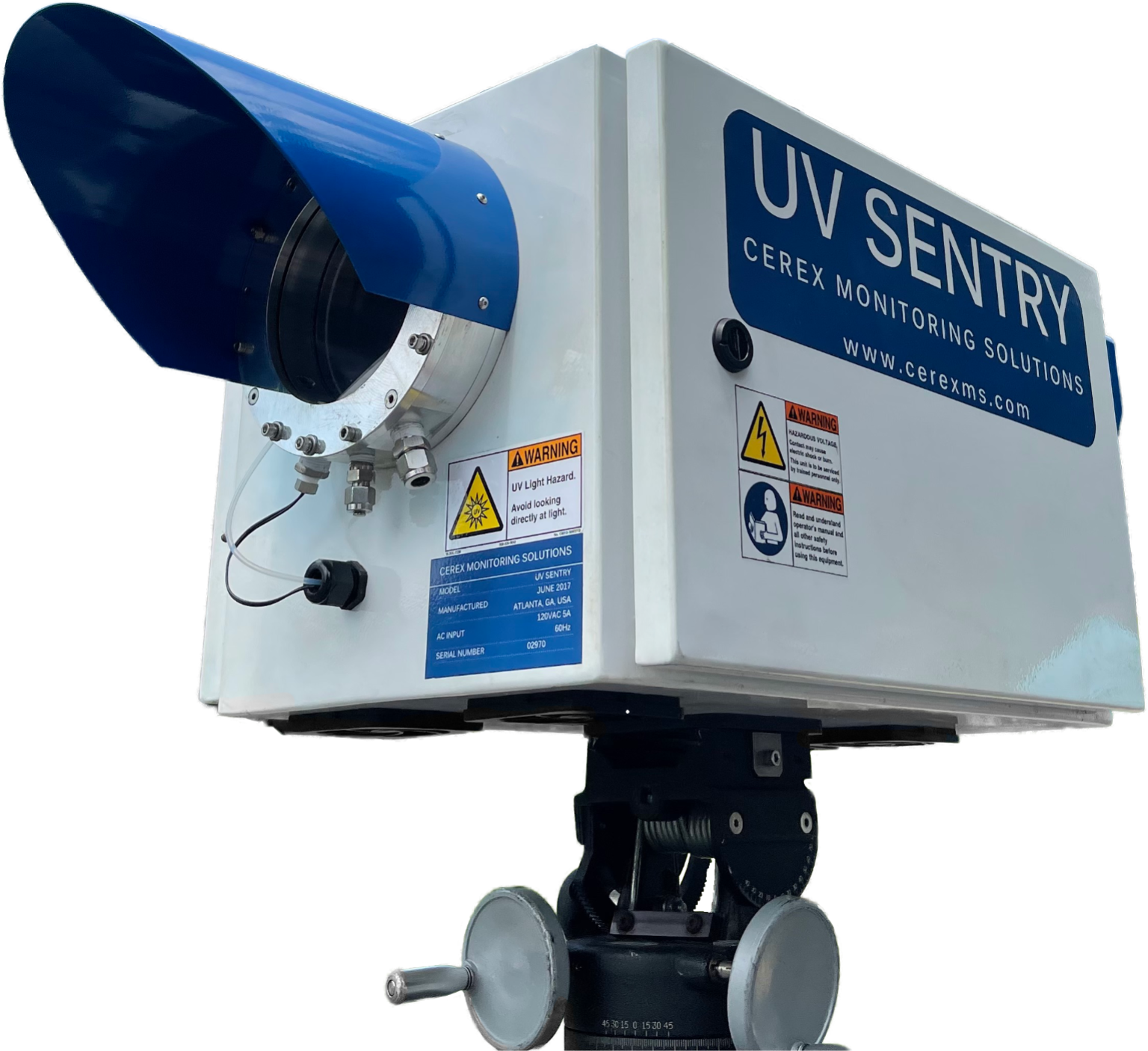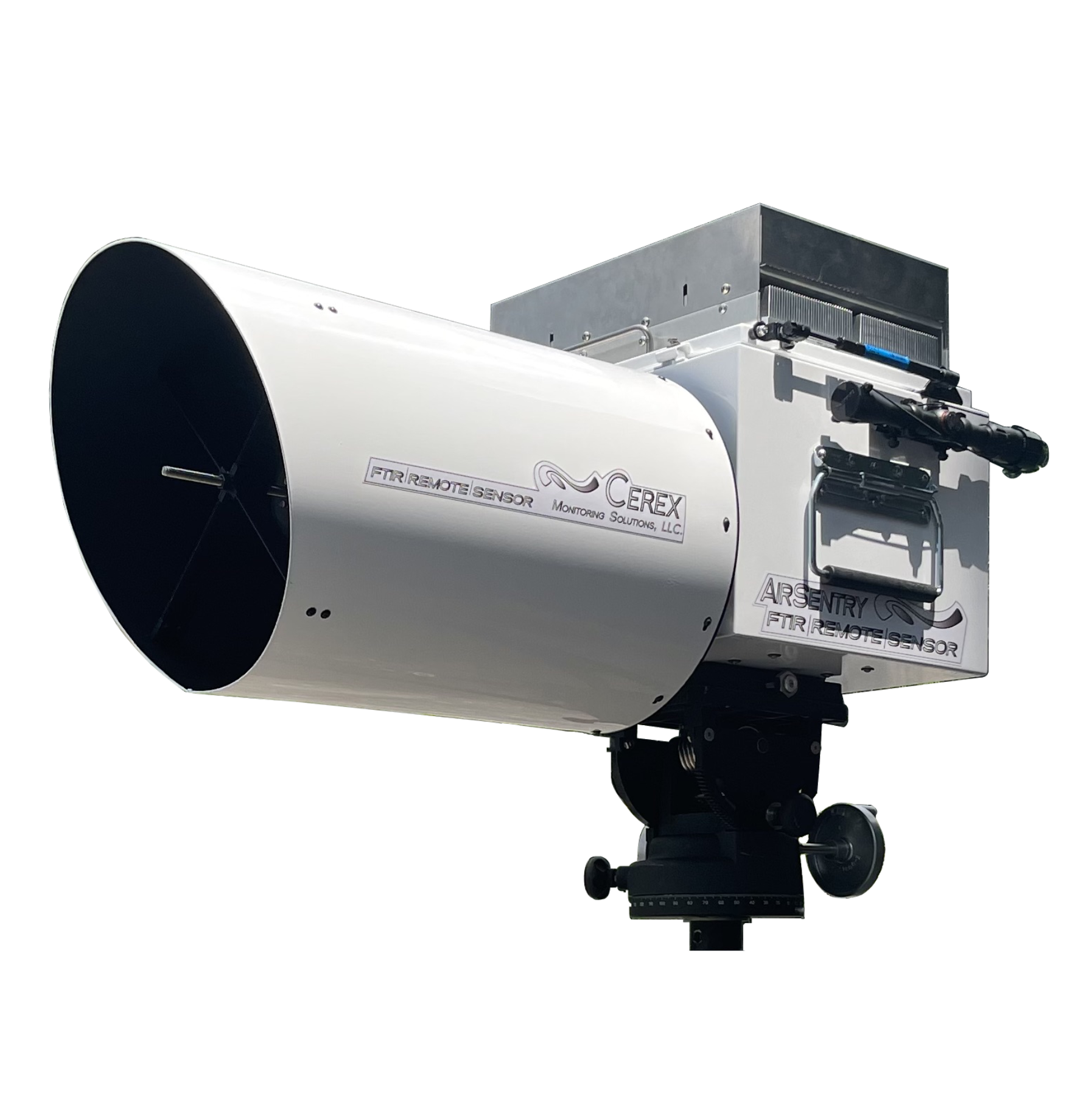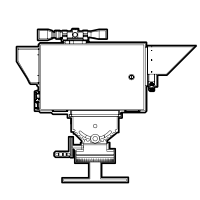Open Path Fence-line Analyzers
Providing gas detection capabilities to facilities seeking to monitor fugitive gases
What is Open Path Monitoring?
Open Path Monitoring is a technique used to analyze concentrations of air gases. It’s particularly useful for monitoring the fugitive gases of industrial refineries, plants, and factories. These gases are typically released into the atmosphere as by-products of manufacturing processes (petroleum plants, etc.) and have the potential to impact surrounding environments through wind or circulation. In order to comply with government regulations and ensure the health and safety for neighboring communities, waterways, and employees, these specific gases need to be identified and quantified to ensure any hazardous compounds are within agreed thresholds.
Cerex’s long-ranging open path systems are used along the perimeters of industrial facilities to monitor levels of fugitive gases crossing the boundaries of the property
Cerex has spent decades engineering equipment to meet these challenges and have perfected two different types of open-path gas analyzers: the Cerex UV Sentry and Cerex AirSentry FTIR. Utilizing UV-DOAS or FTIR technology, these analyzers are often installed along the fence-lines of facilities and are able to identify, quantify, and monitor all present gases across long distances (over 1000km) in one convenient package.
- Suited for air toxics, hazardous air pollutants, combustion gases, alkanes, VOC’s, and hydrocarbons
- Gapless coverage over distances up to 1km
- Down to parts per trillion (ppt) minimum detection levels
- Can be configured to monitor stack emissions where traditional systems are not feasible
- Compliance with US EPA 40 CFR § 63.658 / Method 325 A/B, SCAQMD Rule 1180, BAAQMD Refinery Regulation 12 Rule 15, USEPA TO-16, RCER-2020
How does Open Path Monitoring work?
The analyzer directs a beam of light through the air and the light is reflected back to the analyzer by a retroreflector
Cerex open-path analyzers don’t need to intake any air to be able to identify and quantify the chemicals. Unlike portable point analyzers or extractive CEMS systems that intake air into the instrument, an open-path analyzer uses an internal radiation source (ultraviolet, visible, or infrared) to project a beam of light across an external, ambient air sample.
The absorption spectrum of light, unique to each gas species, is measured and recorded
The beam of light projected by an open-path analyzer interacts with the gaseous compounds within the air sample and, depending on the wave length, causes molecules of those gases to absorb the light and start to vibrate/rotate. Software on an open path analyzer can then use this information to ultimately translate the vibrations of the molecules into useable data.
Cerex analyzers identify the gases by referencing a vast library of light absorption references
Due to principles of physics concerning electromagnetic radiation (see Beer-Lambert’s Law), Cerex’s unique analysis software outputs the type and concentrations of any gases within the air samples with near complete accuracy – in real-time. No intake gases, combined with Cerex’s uniquely engineered equipment and software, means cost and maintenance is extremely reduced.

Why choose a Cerex Open Path Analyzer?

Decades of proven testing, iterations, and development
Since producing the first commercially available Open-Path FTIR remote sensing analyzer in 1994, Cerex has continued to improve it’s open-path technologies for increased reliability, accuracy, and ease of user experience. After decades of success with the AIR SENTRY, Cerex expanded its capabilities with the introduction of the UV SENTRY to target more gases previously undetectable with infrared technologies. Decades of iterations and development has led to instruments of incomparable quality and performance that Cerex is proud to provide.

High-quality parts that overcome open-path limitations
The convenience of open path monitoring is offset by environmental conditions (water vapor, fog, humidity), which can affect the beam in which the gases are monitored. Compounds such as water vapor can absorb light at multiple wavelengths – “muddling” the data and making it hard to distinguish target gases in the overlap regions. One solution to this is considering if the environment can be made suitable for the installation. In the case of most open-path analyzers that are placed along refinery fencelines, environmental conditions can not be controlled. Thus, a more holistic solution is to use a high resolution instrument capable of monitoring spectrum regions with no overlap. Cerex’s UV SENTRY and AIR SENTRY use high resolution spectrometers to effectively overcome this challenge.

Tested by the US EPA and complies with national and international standards (TO-16, etc.)
The US EPA and government agencies have used Cerex open path analyzers to conduct studies on the efficacy of open path UV DOAS and FTIR spectroscopy systems for fenceline monitoring. Depending on which analyzer chosen, Cerex Open Path analyzers meet the following requirements
40 CFR § 63.658 USEPA Method 325 A/B
SCAQMD Rule 1180
BAAQMD Refinery Regulation 12 Rule 15
USEPA TO-16
RCER-2020

Trusted by nearly every major USA-based oil and gas company
Shell Oil, Valero, Exxon Mobile, Flint Hills Resources, PBF Energy, Phillips 66, British Petroleum, Marathon, and others have acquired dozens of Cerex UV Sentrys and AirSentry FTIRs at their refineries. Some feature real-time data from our instruments on their public-facing websites designed to show present and historical gas concentration data for each fenceline segment covered.
Detect concentrations of hundreds of gases in real-time over long distance.
Our open-path monitors utilize an expansive library of detectable gases for continuous monitoring, from hazardous health sites to refinery emissions. Cerex open-path analyzers feature software programmable adjustment of alarm levels and user configurable relay activated alerts for gas faults. Alarm outputs include 4-20mA signals and SPDT relays for fast, reliable warning. Combined with a wireless or wired network, our analyzers can relay concentration levels from remote locations to a central control station for immediate response.
For emergency response teams requiring the same performance of an open-path monitor without the setup time, our Hound, Mini-Hound, Micro-Hound, and Shepherd offer part per billion (ppb) detection levels in an easy to use, ultra portable package.[clearline][one_third]
Open-Path UV Sentry
The UV Sentry is a low cost open-path UV analyzer capable of accurate part per trillion (ppt) to percent detection levels. The UV Sentry can detect gases which may lead to human health hazards, often with lower detection limits than an IR based system. The UV Sentry is capable of detecting multiple compounds including chlorine, ammonia, and mercury.[/one_third][two_thirds_last] [/two_thirds_last][one_third]
Open-Path Sentry MS
The Sentry-MS is a mono-static open-path UV analyzer capable of accurate part per trillion (ppt) to percent detection levels. The Sentry-MS achieves lower detection limits than the UV Sentry over the same path length due to its double pass design. The Sentry-MS is capable of detecting the same extensive list of compounds with better detection limits by a factor of two.[/one_third][two_thirds_last] [/two_thirds_last][one_third]
Open-Path AirSentry FTIR
With hundreds of detectable compounds, the AirSentry FTIR is the monitoring solution for petrochemical industries, semiconductor plants, and site surveys of historically polluted areas. AirSentry is the most portable open-path FTIR sensor available in the industry.[/one_third][two_thirds_last] [/two_thirds_last][button color=”darkgreen” size=”large” caption=”for more information” link=”http://cerexms.com/contact/” align=”center”]Email Cerex[/button]

UV Sentry Series
Best open-path detection limits for Benzene & VOCs
Refinery Fence-line Air Monitoring

Air Sentry
Hundreds of detectable gases
Refinery Fence-line Air Monitoring
Rule 1180


